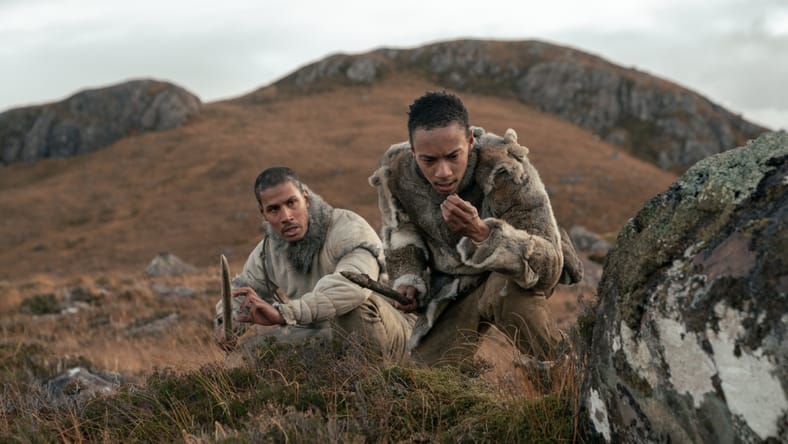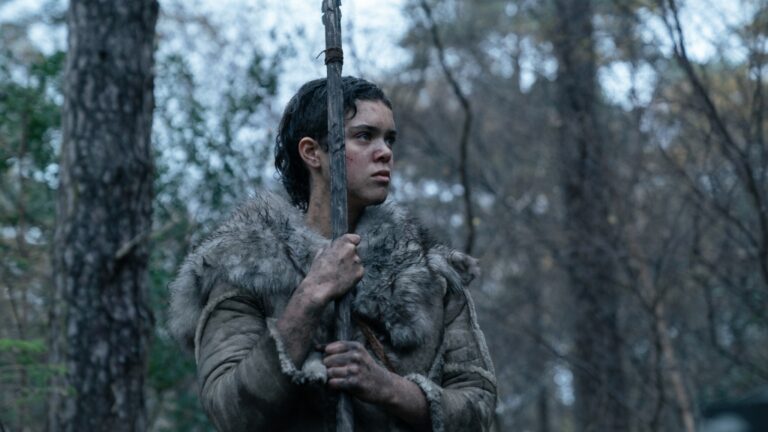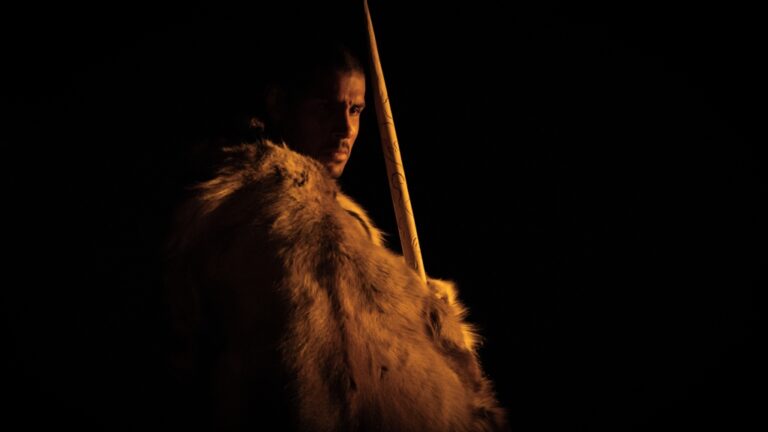
Andrew Cumming’s feature directorial debut, Out of Darkness, tells a stone-age horror story about a group of six early humans who land on the shores of mainland Britain 45,000 years ago. But their search for a fresh start turns sour when a primal fear — and a knee-jerk reaction — is awakened by the sound of terrifying screams coming from the forest beyond.
Exploring the reasoning behind the choices humanity has made to survive over thousands of years, Cumming gives us the chance to experience the perspective of our ancestors — and the things that made the hairs on the back of their neck stand up.
“What’s happening beyond the firelight? That’s something that we inherently carry with us. I mean, the next time you go camping and the fire dies down, it’s pretty scary,” Cumming tells MovieMaker.
“I think the horror genre, maybe more than any other, allows you to slip these messages in underneath the splatter and the mayhem that comes about.”
Safia Oakley-Green stars as the story’s unlikely heroine, Beyah, a strong-willed young woman who discovers the barbaric choices required to survive in the face of a new enemy.
The screenplay for Out of Darkness was written by Ruth Greenberg, with a story by credit from Cumming and producer Oliver Kassman. Other cast includes Chuku Modu, Kit Young, Iola Evans, Luna Mwezi, Arno Lüning, Rosebud Melarkey, and Tyrell Mhlanga.
In the below Q&A, Cumming tells us about all the historical research into early human history that he did to make the film as realistic as possible; the trick to making a monster feel scary using only practical effects, and how the classic archetypes of the horror genre found there way into his group of stone age characters. Warning: This Q&A contains spoilers for the movie. Out of Darkness arrives in theaters on Feb. 9.
Q&A with Out of Darkness Director Andrew Cumming

MovieMaker: What inspired you to make a horror movie set in the stone age?
Andrew Cumming: I was finishing film school and I saw a documentary on the BBC about early modern humans. And I just thought, what an amazing time period, and it’s not really been done a lot in cinema. It’s an opportunity maybe to see something quite interesting about us as a species. And then I read this great novel by William Golding called The Inheritors, which was his follow up to Lord of the Flies, which again, just left me realizing the amazing potential of this time period and what you can do. And from then on, I just became obsessed. I read this great book called Sapiens by Yuval Noah Harari, which is all about human history. And yeah, just sort of deep dived into the research that we’ve have gathered and amassed since movies like Quest for Fire. It just felt like there was a there was a chance to do something like an update on those kinds of movies.
MM: Was this tribe of characters based on any specific ancient culture? Where was this meant to have taken place?
AC: Loosely, it’s takes place in mainland Britain 45,000 years ago. The idea is, you can’t really see it extremely well, but in the background of the shot, there is land beyond. Immediately speaking, the six characters that we follow maybe have crossed a wide expanse of water, but not like an ocean. They’ve come from another area, because the backstory was that Adem, the leader, he’s fallen out with the rest of the tribe, because he thought, ‘I think we should go this way.’ They’ve said, ‘We want to go that way.’ So he’s a very proud man who wants to create a dynasty for his young son and his eventual offspring. He decides to take his immediate people and ventured out on his own. So yeah, male pride and ego is his downfall.
MM: How did your research inform the way you wrote the characters?
AC: It was reading a lot of books on the subject, going to museums. We also were very lucky to get one of the foremost experts in early modern humans in the UK to speak to us. He really encouraged us, actually, because there are two schools of thought when it comes to digging bones out of the ground. One is, ‘Well, we didn’t dig it up, we can’t prove it.’ Whereas [he] is more of the the opinion that if we can do it, they could do it — but they did it differently.
For example, early modern humans from that period could straighten ivory, but we have no idea how they did it. We don’t know exactly how they took mammoth tusks, and, you know. So these people were smart, they were cultured — there’s strong evidence that their brains were actually bigger than ours are now. So you wonder what knowledge they were retaining about the natural world that they needed to pass on to future generations. Like, don’t touch that, it’s poisonous! The research really helped encourage us to do a lot more blue sky thinking. And that’s what I said to my heads of department — to research up until a point, but then let’s explore different avenues and remember that we are making a movie.
MM: This movie starts out as potentially supernatural, but then it evolves into something else. What themes or lessons about humanity were you trying to convey through this storyline?
AC: The whole movie is about inhumanity, and asks the quite uncomfortable question: Are we at the top of the food chain because of our inhumanity? You look back through history, whether it was the Third Reich or the Reformation — we just have this habit of demonizing anyone that’s different to us and justifying their extinction. So yeah, that was definitely one of the central pillars of the film going forward, that thesis that we held on to throughout.
Obviously the horror genre is a great place to explore that. I think the horror genre, maybe more than any other, allows you to slip these messages in underneath the splatter and the mayhem that comes about. And that’s the other thing — these supernatural stories, they come from somewhere, right? The devil has an origin story, probably rooted in something quite benign, something that we couldn’t explain. That also ties into why we have the Aurora Borealis sequence as well. It was trying to find these moments of wonder that we can explain now, but 45,000 years ago, it would’ve just felt like, is the world going to end? What’s happening beyond the firelight? That’s something that we inherently carry with us. I mean, the next time you go camping and the fire dies down, it’s pretty scary. We carry that in us, and that’s just something that goes back to our primeval past, I suppose.
Also Read: Out of Darkness Trailer Tells a Bone-Chilling Stone Age Horror Story Set in 43,000 B.C. (Video)
MM: As a filmmaker, how did you convey that supernatural feeling of fear and monsters using only practical effects?
AC: This is where I bow down at the altar of Paul Davies, or sound designer. He very quickly read the script and said, ‘This has to be done in Dolby Atmos.’ And I said, ‘Yes, very good. I agree.’ But for those that aren’t lucky enough to see it in a Dolby Atmos cinema, what Paul and his team have done is just create this — whenever you couldn’t see the monster, we were able to exaggerate, because it becomes a subjective experience for our heroes, our camp of Homo sapiens. So you’re able to play with the darkness and play with noises left, right, up, down, and create this great sonic tapestry that is meant to jolt you in a narrow view.
Also we kind of, at times, cheated a little bit and made this thing seem bigger or faster or more omnipotent. And then obviously, it’s revealed to be — I mean, these are all spoilers. We’re getting into spoiler territory here, but the minute you show this thing, it’s over. And similar to whether you’re from the alien camp or you love Jaws, I think the less you see of these things, the more it builds up in the audience’s head. And it would have been the same for these people back then. If you moved into new territory and you heard some strange screaming noise from an animal, I mean, it could be anything. So that’s a super powerful place to play in the horror genre.

MM: Tell me about the archetypes that you’ve chosen for these six characters.
AC: The idea was, everybody should be able to watch the film and recognize some character trait that they either have or that they’ve seen in other people. Also, we are tipping our hat to the genre, because if you remember in A Cabin in the Woods, they break down the archetypes, right? So you’ve got the athlete, you’ve got the scholar, you’ve got the clown, you’ve got the quote-unquote virgin and the quote-unquote whore. We didn’t realize that subconsciously we were following these tropes of the horror genre. And then I guess it’s how you mess with that and how you dress up in different way.
But certainly, I think what Adem represents in terms of the patriarchy, and in terms of that aggressive, alpha male who has basically been in charge of the world for a few thousand years and what impact that kind of leader can have on people, and especially on the young and the vulnerable. There’s no coincidence that Beyah, the lead character played by Safia Oakley-Green — fantastic performance from her in her first movie — there’s no coincidence that Beyah has this kill switch that comes out over the course of the movie because of what she’s endured, and because of what she was going to endure if they had made it to this cave, and what she would have become under Adem. So you know, that’s all deliberate.
MM: I loved the choice to have Beyah, who starts out as sort of the runt of the litter in the view of the others in her group, end up being the main character. Tell me about that choice.
AC: It was a comment on, if you treat people this way, if we have a certain leadership that punches down and oppresses and abuses the vulnerable, do not be surprised when they become monsters themselves. And again, that ties into the central thesis of the film, that humans survived because of their monstrosity. Humans survived because of our own humanity. And asking the question, is this what we’ve always been and always will be, or can we change? I love the idea, just purely on a storytelling level, that this young lady, you say the runt of the litter, by the end of the second act has become a genocidal maniac. But in her head, it’s completely justified — it’s them or us, you know? Whether it’s what’s happening in Gaza, or what’s happening in Kyiv. Need I say more? It’s always them or us. Will we ever change?
MM: Something else I noticed is that there’s never an attempt by Beyah and Adem’s camp to try to communicate in any meaningful way with the other camp, or vice-versa. Tell me about that choice?
AC: No, there couldn’t be. In an early draft of the script, as Beyah was going on her death march through this cave, we were cross-cutting and showing all this evidence of culture and all this evidence technical sophistication and ingenuity. And at some point, we realized that that level of dramatic irony was really problematic, because in that moment, you need to be with Beyah. You need to be saying, ‘Kill, kill, kill!’ So that when we do reveal what what these other things were and what they’d done to help one of Beyah’s own, you realize that you are a party to that bloodlust, that insatiable need to survive.
That was very deliberate, because every Caucasian person in Western Europe has at least 4% Neanderthal DNA inside them. So we know we did more than talk, okay? But I think that’s a different movie, because again, there’s no coincidence that Neanderthals had been around for 300,000 years and then we come along and within 18,000 years, they’re all gone. So I don’t believe it was all romantic gifts and candlelit dinners. People were fighting for territory, and probably that would have been what we’re talking about — demonizing the other.
This interview has been edited for clarity.
Main Image: Chuku Modu and Kit Young in Out of Darkness courtesy of Bleecker Street
Share:

